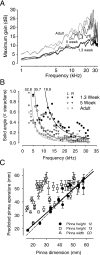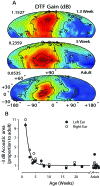Postnatal development of sound pressure transformations by the head and pinnae of the cat: monaural characteristics
- PMID: 19206874
- PMCID: PMC2736725
- DOI: 10.1121/1.3058630
Postnatal development of sound pressure transformations by the head and pinnae of the cat: monaural characteristics
Abstract
Although there have been many anatomical, physiological, and psychophysical studies of auditory development in cat, there have been no comparable studies of the development of the sound pressured transformations by the cat head and pinnae. Because the physical dimensions of the head and pinnae determine the spectral and temporal transformations of sound, as head and pinnae size increase during development, the magnitude and frequency ranges of these transformations are hypothesized to systematically change. This hypothesis was tested by measuring directional transfer functions (DTFs), the directional components of head-related transfer functions, and the linear dimensions of the head and pinnae in cats from the onset of hearing ( approximately 1.5 weeks) through adulthood. Head and pinnae dimensions increased by factors of approximately 2 and approximately 2.5, respectively, reaching adult values by approximately 23 and approximately 16 weeks, respectively. The development of the spectral notch cues to source location, the spatial- and frequency-dependent distributions of DTF amplitude gain (acoustic directionality), maximum gain, and the acoustic axis, and the resonance frequency and associated gain of the ear canal and concha were systematically related to the dimensions of the head and pinnae. These monaural acoustical properties of the head and pinnae in the cat are mature by 16 weeks.
Figures








Similar articles
-
Concurrent development of the head and pinnae and the acoustical cues to sound location in a precocious species, the chinchilla (Chinchilla lanigera).J Assoc Res Otolaryngol. 2011 Apr;12(2):127-40. doi: 10.1007/s10162-010-0242-3. Epub 2010 Oct 19. J Assoc Res Otolaryngol. 2011. PMID: 20957506 Free PMC article.
-
Postnatal development of sound pressure transformations by the head and pinnae of the cat: Binaural characteristics.J Acoust Soc Am. 2009 Dec;126(6):3125-36. doi: 10.1121/1.3257234. J Acoust Soc Am. 2009. PMID: 20000926 Free PMC article.
-
Development of the head, pinnae, and acoustical cues to sound location in a precocial species, the guinea pig (Cavia porcellus).Hear Res. 2017 Dec;356:35-50. doi: 10.1016/j.heares.2017.10.015. Epub 2017 Nov 1. Hear Res. 2017. PMID: 29128159 Free PMC article.
-
Sound pressure transformations by the head and pinnae of the adult Chinchilla (Chinchilla lanigera).Hear Res. 2011 Feb;272(1-2):135-47. doi: 10.1016/j.heares.2010.10.007. Epub 2010 Oct 27. Hear Res. 2011. PMID: 20971180 Free PMC article.
-
[Sound localization cues of binaural hearing].Laryngorhinootologie. 2003 Apr;82(4):240-8. doi: 10.1055/s-2003-38932. Laryngorhinootologie. 2003. PMID: 12717598 Review. German.
Cited by
-
Effects of forward masking on sound localization in cats: basic findings with broadband maskers.J Neurophysiol. 2013 Oct;110(7):1600-10. doi: 10.1152/jn.00255.2013. Epub 2013 Jul 10. J Neurophysiol. 2013. PMID: 23843432 Free PMC article.
-
The role of spectral composition of sounds on the localization of sound sources by cats.J Neurophysiol. 2013 Mar;109(6):1658-68. doi: 10.1152/jn.00358.2012. Epub 2012 Dec 28. J Neurophysiol. 2013. PMID: 23274314 Free PMC article.
-
Keeping an ear out: size relationship of the tympanic bullae and pinnae in bandicoots and bilbies (Marsupialia: Peramelemorphia).Curr Zool. 2021 Jul 10;68(3):251-264. doi: 10.1093/cz/zoab055. eCollection 2022 Jun. Curr Zool. 2021. PMID: 35592340 Free PMC article.
-
Decoding neural responses to temporal cues for sound localization.Elife. 2013 Dec 3;2:e01312. doi: 10.7554/eLife.01312. Elife. 2013. PMID: 24302571 Free PMC article.
-
Behavioral and modeling studies of sound localization in cats: effects of stimulus level and duration.J Neurophysiol. 2013 Aug;110(3):607-20. doi: 10.1152/jn.01019.2012. Epub 2013 May 8. J Neurophysiol. 2013. PMID: 23657278 Free PMC article.
References
-
- Carlile, S., and King, A. J. (1994). “Monaural and binaural spectrum level cues in the ferret: Acoustics and the neural representation of auditory space,” J. Neurophysiol. 71, 785–801. - PubMed
Publication types
MeSH terms
Grants and funding
LinkOut - more resources
Full Text Sources
Miscellaneous

